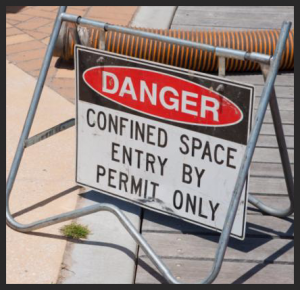| Sweating the Small Stuff | Confined Spaces |
The term “confined spaces” refers to spaces that were not designed for continuous employee occupancy, but are large enough for an employee to enter and perform work. Often these spaces have been configured mainly to transport products or services, store products, or enclose a material or process. The space will have limited means of entry or exit for workers who need to provide maintenance, repair, inspection, cleanup and other activities. Some common examples of confined spaces include manholes, tunnels, tanks, vessels, pipelines, ductwork, pits, and sewers.

There are several dangers associated with working in confined spaces, such as increased risk of serious injury from hazards like engulfment, entrapment, and hazardous atmospheric conditions. Unfavorable ventilation conditions in confined spaces can cause deadly gases to accumulate. Also, oxygen levels in the confined space can become dangerously low for breathing or dangerously high and susceptible to fire or explosion. Physical confinement within the space can cause workers to become trapped, or put workers in closer proximity to hazards, such as machinery, than they would be otherwise.
OSHA has developed requirements and tools to help protect employees from the dangers of confined spaces. Workers in general industry are required by OSHA to have a permit to enter any confined spaces which meet one or more of the following conditions: Contains (or has the potential to contain) a hazardous atmosphere; Contains a material which could engulf someone in the space; Has a configuration which could trap or asphyxiate someone with inwardly converging walls or a floor that slopes downward and tapers to a smaller cross section; Contains any other recognized safety or health hazards, such as heat stress or exposed live wires.
There are additional OSHA confined space requirements for general industry which include providing worker training, following duty assignments, developing a written program with procedures to control hazards, and more. Separate OSHA confined spaces rules apply to construction, agriculture, ship yards, marine terminals, and longshoring, and can be reviewed on the OSHA website.
Since confined spaces can be found in a variety of occupations, it is vitally important that confined spaces in the workplace be identified and their potential hazards be assessed. Employers need to ensure they are familiar with applicable confined space requirements and need to inform exposed employees of the existence of confined spaces, their locations and their hazards.
For additional information on Confined Spaces, see OSHA’s Confined Spaces Page. We also offer the following Confined Space courses: Confined Space Awareness – Online | Confined Space Entry (16 Hr) – Classroom | Confined Space Entry Refresher (8 Hr) – Classroom



